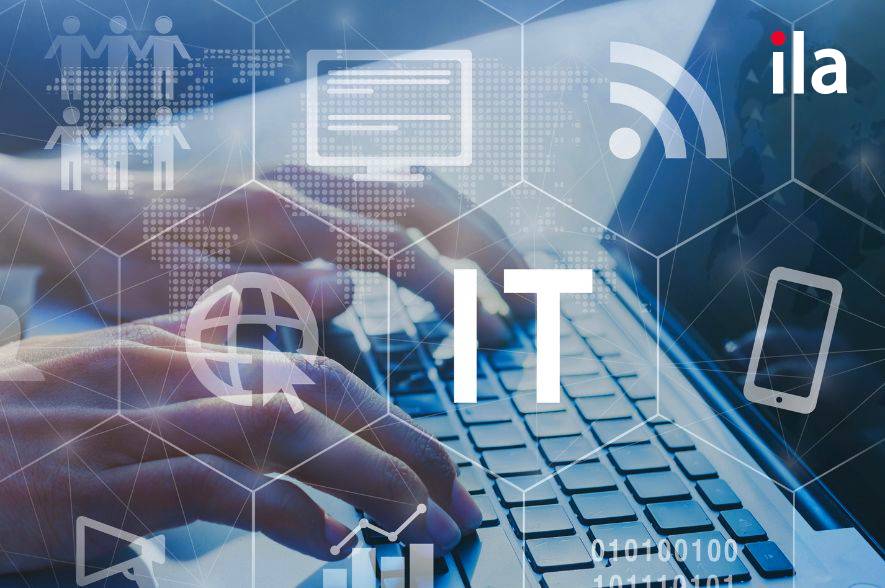Tìm hiểu về tiếng Anh chuyên ngành Công nghệ thông tin giúp bạn cải thiện khả năng làm việc và nâng cao cơ hội nghề nghiệp.
Tiếng Anh chuyên ngành công nghệ thông tin là gì?

Công nghệ thông tin (CNTT) tiếng Anh là Information Technology (IT) là một lĩnh vực kỹ thuật chuyên sử dụng máy tính và phần mềm để xử lý, chuyển đổi, bảo vệ, lưu trữ, truyền tải và thu thập thông tin. Ngành CNTT đóng vai trò quan trọng trong hầu hết các lĩnh vực khác của đời sống, góp phần thúc đẩy sự phát triển kinh tế, xã hội và nâng cao chất lượng cuộc sống.
Đặc điểm nổi bật của ngành CNTT:
• Phát triển nhanh chóng: CNTT luôn được cập nhật và đổi mới không ngừng với tốc độ chóng mặt, mang đến những giải pháp mới mẻ và hiệu quả cho các vấn đề trong mọi lĩnh vực.
• Tiềm năng to lớn: Nhu cầu sử dụng CNTT ngày càng tăng cao trong mọi lĩnh vực, tạo ra nhiều cơ hội học tập, nghiên cứu và phát triển cho các cá nhân và tổ chức.
• Yêu cầu cao: Để thành công trong ngành CNTT, đòi hỏi bạn phải có kiến thức chuyên môn sâu rộng, kỹ năng thực hành thành thạo và khả năng thích ứng nhanh nhạy với những thay đổi của công nghệ.
Từ vựng tiếng Anh chuyên ngành Công nghệ thông tin
Dưới đây là một số từ vựng tiếng Anh chuyên ngành Công nghệ thông tin được phân thành các nhóm:
1. Vị trí làm việc (Position title)
2. Từ vựng về Dữ liệu (Data)

3. Phần cứng (Hardware)
4. Từ vựng về Phần mềm (Software)

6. Từ vựng về Bảo mật (Security)

7. Phát triển (Software Development)
>>> Tìm hiểu thêm: Tất tần tật các giới từ trong tiếng Anh bạn cần nắm vững
Thuật ngữ và từ viết tắt khi học tiếng Anh chuyên ngành Công nghệ thông tin

Giáo trình tiếng Anh chuyên ngành Công nghệ thông tin

Một số giáo trình về tiếng Anh chuyên ngành Công nghệ thông tin phổ biến bạn có thể tham khảo như:
1. Check Your English Vocabulary for Computers and Information Technology
Tác giả: Jon Marks
Giáo trình này cung cấp bài tập kiểm tra và từ vựng tiếng Anh CNTT, bạn sẽ được củng cố và ghi nhớ từ vựng tiếng Anh chuyên ngành CNTT hiệu quả.
2. Oxford English for Information Technology
Tác giả: Eric H. Glendinning & John McEwan
Giáo trình cung cấp kiến thức tiếng Anh CNTT ở trình độ trung cấp, bao gồm từ vựng, ngữ pháp, kỹ năng giao tiếp và viết. Thêm nữa, giáo trình này có nội dung thực tế, cập nhật các thuật ngữ mới nhất trong ngành CNTT, với bài tập đa dạng, phong phú, giúp bạn luyện tập hiệu quả.
3. English for Information Technology
Tác giả: Maja Olejniczak
Cung cấp kiến thức tiếng Anh chuyên ngành Công nghệ thông tin ở trình độ cơ bản, bao gồm từ vựng, ngữ pháp và kỹ năng giao tiếp cơ bản. Giáo trình này khá dễ hiểu, phù hợp với người mới bắt đầu học tiếng Anh chuyên ngành CNTT.
>>>Tìm hiểu thêm: 100 động từ bất quy tắc thường gặp & 30 danh từ bất quy tắc phổ biến
Đề thi tiếng Anh chuyên ngành Công nghệ thông tin

I. Choose the most appropriate answer for each question below (3M):
1. Floppy disks are _____ expensive and reusable.
A. in- B. un- C. ir- D. im-
2. Once you finish your program, you will have to test it and _____ bug it to remove all the mistakes
A. de- B. re- C. auto- D. pre
3. The laser printers are preferable to other types of printing devices because of their speed and quiet _____
A. -less B. -ness C. -ity D. -ify
4. We decided to computer _____ the entire plant to give each division more independence
A. -ate B. -ize C. -en D. -al
5. The _____ imal system is a number system with a base of 10
A. tri- B. de- C. bi- D. un-
6. This email has been encrypted. It can only be read after being _____ coded.
A. en- B. de- C. re- D. dec-
7. ____________ can adjust the space between successive characters to produce a ‘best fit’.
A. Maths functions B. Auto-kerning C. Style sheets D. Outliner
8. The term DBMS stands for Database _____________ System.
A. Manipulation B. Making C. Management D. Multiple
9. VGA stands for Video Graphics _____________.
A. Access B. Array C. Accumulator D. Accelerator
10. The term SQL stands for ____________ Query Language
A. Structured B. Sentence C. Standard D. Simple
11. Developing high-quality curriculum materials and encourage other publishers to do the same.
A. term B. semester C. course D. education
12. Such programs as Adobe Photoshop, Microsoft Word and Windows Media Player are called _____ programs.
A. systems B. applications C. source D. object
13. The clipboard technology allows the computer to figure out what that data means.
A. find out B. help out C. get out D. understand
14. Eventually, we are all going to be interlinked, no matter what service we use.
A. However B. Meanwhile C. Ultimately D. Whereas
15. A Trojan horse cannot propagate on its own.
A. activate B. proliferate C. eliminate D. debate
Đáp án tiếng Anh chuyên ngành Công nghệ thông tin
| 1. A. in- | 2. B. re- | 3. B. -ness | 4. B. -ize | 5. A. tri- |
| 6. B. de- | 7. B. Auto-kerning | 8. C. Management | 9. B. Array | 10. A. Structured |
| 11. C. course | 12. B. applications | 13. D. understand | 14. C. Ultimately | 15. B. proliferate |
II. Choose the appropriate form of the word to fit the meaning of the sentence (you may have to change some words slightly) (2M):
1. electron, electronic, electronics, electronically
a. An __________ pen is one example of an input device.
b. A computer solves problems__________.
c. Many__________ students go on to work as engineers.
2. technology, technological, technologically, technologists
a. The computer is the greatest __________ invention of the twentieth century.
b. There are two __________ involved in a clipboard PC.
c. Today’s computers are __________ far superior to those used a few years ago.
Đáp án tiếng Anh chuyên ngành Công nghệ thông tin:
| 1 | 2 |
| a. electronic
b. electronically c. electronics |
a. technological
b. technologies c. technologically |
III. Read the text below carefully, then do the following exercises:

The objective of information systems is to provide information to all levels of management at the most relevant time, at an acceptable level of accuracy, and an economical cost.
Individual businesses require information according to the nature of their operations. A car manufacturer is particularly interested in the extent of competition from overseas manufacturers in the home market and competition from other home-based manufacturers. A tour operator is concerned about purchasing power and its effect on holiday bookings and the political situation prevailing in the various countries.
As a general guide, the detail contained in reports containing information varies according to the position of the recipient in the hierarchical management structure. The chairman and managing director of a company require details of operations that are broad in scope and concentrate on key factors pinpointing economic and financial trends. Functional management requires information relating to the departments they are responsible for in sufficient detail to enable them to apply whatever measures are required to bring situations into line with requirements. They require information relating to events as they occur so that appropriate action can be taken to control them.
Information systems are often computerized because of the need to respond quickly and flexibly to queries. At the bottom level in the information hierarchy are the transaction processing systems, which capture and process internal information, such as sales, production, and stock data. These produce the working documents if the business, such as invoices and statements. Typically, these are the first systems that a company will install. Above the transaction-level systems are the decision support systems. These take external information market trends and other external financial data – and process internal information, such as sales trends, to produce strategic plans, forecasts, and budgets. Often such systems are put together with PC spreadsheets and other unconnected tools. Management information systems lie at the top of the hierarchy of information needs. The MIS takes the plans and information from the transaction-level systems to monitor the performance of the business as a whole. This provides feedback to aid strategic planning, forecasting, and/or budgeting, which in turn affects what happens at the transactional level.
A. Answer these questions about the text (2M):
1. What does the text mainly talk about?
2. What do the decision support systems do?
3. What are there at the bottom level of the information hierarchy?
4. What is the function of MIS?
B. Use the line references given, look back in the text, and find the words or phrases with a similar meaning to (2M):
1. connected (lines 1 – 2)
2. existing (lines 5 – 7)
Đáp án tiếng Anh chuyên ngành Công nghệ thông tin
A.
1. The text mainly talks about information systems and their role in providing relevant information to different levels of management.
2. Decision support systems process external and internal information to produce strategic plans, forecasts, and budgets.
3. At the bottom level of the information hierarchy are transaction processing systems, which capture and process internal information such as sales, production, and stock data.
4. The function of Management Information Systems (MIS) is to monitor the performance of the business as a whole by taking plans and information from transaction-level systems and providing feedback to aid strategic planning, forecasting, and/or budgeting.
B.
1. connected (lines 1 – 2) = relevant
2. existing (lines 5 – 7) = prevailing
Bài tập tiếng Anh chuyên ngành Công nghệ thông tin

Ngoài đề thi, bạn có thể tập luyện thêm bằng các bài tập tiếng Anh chuyên ngành Công nghệ thông tin sau đây:
1. What does HTML stand for?
a) Hyper Text Markup Language
b) High Tech Machine Learning
c) Home Tool Management Logic
d) Hardware Testing Methodology
2. Which of the following is not a programming language?
a) Python b) Java c) Photoshop d) C++
3. What is the purpose of a firewall in computer networks?
a) To enhance internet speed
b) To identify a device on a network
c) To prevent unauthorized access
d) To format hard drives
4. What does VPN stand for?
a) Virtual Private Network
b) Voice Processing Node
c) Visual Programming Navigator
d) Value Proposition Network
5. What is the function of a router in a network?
a) To connect multiple networks together
b) To format text documents
c) To play audio files
d) To encrypt sensitive information
Đáp án
Kết luận
Việc nắm vững tiếng Anh chuyên ngành Công nghệ thông tin mang lại nhiều lợi ích cho bạn. Khả năng giao tiếp tiếng Anh tốt cũng rất quan trọng trong môi trường làm việc quốc tế. Việc sở hữu kỹ năng tiếng Anh tốt còn mở ra cơ hội tham gia các khóa học, hội thảo chuyên ngành CNTT uy tín toàn cầu.




